Study Tour to Meet Fishermen and Seafood Processor
Study Tour to Meet Fishermen and Seafood Processors Learns more about Fish from Nagasaki
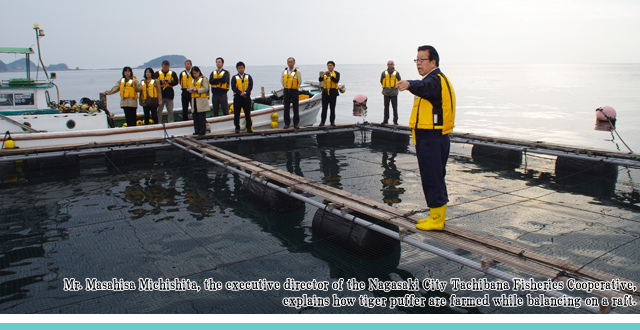
The fisheries industry is now suffering from low fish prices due to a decreasing number of fish lovers and other circumstances. The Seikatsu Club adopted a basic fisheries policy in 2008 in order to strengthen partnerships with production areas. Oumu (Hokkaido), Omoe (Iwate), Mie, Chiba and Nagano were positioned as key production centers, and great efforts have been made to network with these producers. In late October, a total of nine consumer members and staff members of the Seikatsu Club, including Ms. Izumi Ueda, Chairperson of the Seikatsu Club Consumers’ Cooperative Union (SCCCU) Consumption Committee, visited Nagasaki. They talked with members of the JF Nagasaki Gyoren (Japan Fisheries Nagasaki Association of Fishery Cooperatives) about the new products they are developing and visited a tiger puffer farm (posted on December 12).
Discussion on the community-based development of fishery products
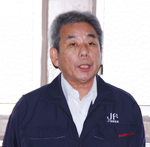 Nagasaki is blessed with the rich bounty of one of the world's most fertile fishing grounds, which stretch from the Goto Islands, Iki Island and Tsushima to the East China Sea. Nagasaki ranks third in fishery yields in Japan. The Seikatsu Club has been working more and more closely with the association of fishery cooperatives in Nagasaki as an indispensable production base for promoting its fisheries policy, since Nagasaki has good landing ports for basic fish varieties such as horse mackerel and mackerel.
Nagasaki is blessed with the rich bounty of one of the world's most fertile fishing grounds, which stretch from the Goto Islands, Iki Island and Tsushima to the East China Sea. Nagasaki ranks third in fishery yields in Japan. The Seikatsu Club has been working more and more closely with the association of fishery cooperatives in Nagasaki as an indispensable production base for promoting its fisheries policy, since Nagasaki has good landing ports for basic fish varieties such as horse mackerel and mackerel.
Twenty new product items, including dried sardine powder, boiled conger eel, farm-raised tiger puffer (for Japanese nabe, winter cuisine served in the pot), and fried fish paste were proposed at the exchange meeting. Before the presentations on the new items, Mr. Shigenori Itatani, Fukuoka Division Director of the JF Nagasaki Gyoren made a welcome speech and spoke to the delegation. “Now we would like to make proposals for community-based products. We, as your production base, hope to strengthen our partnership through dialogue.”
The presentations were made by people who are actually working to develop the new items at fishery cooperatives and seafood processing companies. These cooperatives and companies are members of the JF Nagasaki Gyoren. The delegation from the Seikatsu Club sampled each new item, such as seafood dressed with salt and rice malt, basil sauce, or lemon pepper and fish paste, and also asked questions. “The quantity standard for boiled conger eel is set at 100 grams. Is that because the conger eel which is caught here usually weighs around 100g?" They also expressed their opinions. For example, "One package of tiger puffer is too small if it is 200g. We should reconsider the quantity standard." "We don't need to write on the package that it is for nabe, because it can be used for various recipes."
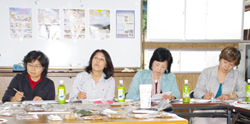 Nagasaki Prefecture has the largest yield of the conger eel family in Japan. 98% of them are caught in the Tsushima area. Conger eels undergo a method called ikejime (or ikijime, a method of paralyzing and bleeding the fish to maintain its quality). They are boiled with soy sauce and other seasonings. Mr. Koki Murase, one of the directors of the Toyotama Town Promotion Corporation answered the questions saying, "Yes, exactly. We had to solve some problems about food additives and could not sell you our boiled conger eels last year. We spent a year developing seasonings to meet your specifications. The conger eels we cooked for the new version of our product were caught in the west of the Tsushima Islands. They are small but tender. We can even eat their small bones," explained Mr. Murase.
Nagasaki Prefecture has the largest yield of the conger eel family in Japan. 98% of them are caught in the Tsushima area. Conger eels undergo a method called ikejime (or ikijime, a method of paralyzing and bleeding the fish to maintain its quality). They are boiled with soy sauce and other seasonings. Mr. Koki Murase, one of the directors of the Toyotama Town Promotion Corporation answered the questions saying, "Yes, exactly. We had to solve some problems about food additives and could not sell you our boiled conger eels last year. We spent a year developing seasonings to meet your specifications. The conger eels we cooked for the new version of our product were caught in the west of the Tsushima Islands. They are small but tender. We can even eat their small bones," explained Mr. Murase.
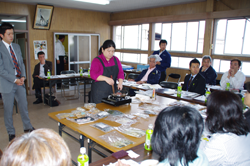 The participants saw the producer of the dried sardine powder using the product to cook. It is made from whole fresh sardines which are caught in Nagasaki Prefecture. "We want children to eat the whole sardine," said Ms. Kyoto Kawabata of Tairei, the manufacturer of the product, explaining the reason why they developed it. She showed the delegation how to cook rice and burdock seasoned with this powdered sardine. After the presentations, members of the Seikatsu Club replied with comments.
The participants saw the producer of the dried sardine powder using the product to cook. It is made from whole fresh sardines which are caught in Nagasaki Prefecture. "We want children to eat the whole sardine," said Ms. Kyoto Kawabata of Tairei, the manufacturer of the product, explaining the reason why they developed it. She showed the delegation how to cook rice and burdock seasoned with this powdered sardine. After the presentations, members of the Seikatsu Club replied with comments.
"When I try new products in a place like this, I can see what kind of background they are produced in. I felt that we should have a sense of getting our food from the whole community." (Ms. Sigeko Tsuji, Chiba)
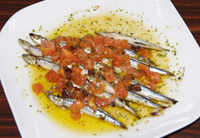 Ms. Atsuko Kikuichi from Saitama said, "I would like to tell younger members how to cook as well as the importance of consuming fish and meat." Ms. Takako Morinaga from Tochigi said, "It is better to cook from scratch, but I felt we sometimes need processed food with seasonings."
Ms. Atsuko Kikuichi from Saitama said, "I would like to tell younger members how to cook as well as the importance of consuming fish and meat." Ms. Takako Morinaga from Tochigi said, "It is better to cook from scratch, but I felt we sometimes need processed food with seasonings."
Then Ms. Izumi Ueda, Chairperson of the SCCCU Consumption Committee pointed out, "You once made a proposal for products which were meant to take advantage of a boom, but the Seikatsu Club takes time when we decide whether to introduce a product or not. By the time we have decided to introduce the product, people's interest may have disappeared. Please keep that in mind all the time. In addition, it is becoming more and more important to tell members how to eat a product. It would be great if you could give us more ideas for cooking."
Visits to Aquaculture Farms and Study Sessions
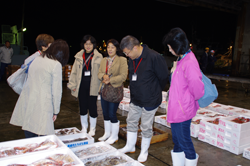 The members visited a tiger puffer farm and a prawn farm. The prawns will be in their product line for the year-end gifts. Study sessions were also held. The delegation visited a fisheries cooperative and learned about marbled rockfish in the “Nagasaki Pack” (a package of seasonal fish caught in Nagasaki).
The members visited a tiger puffer farm and a prawn farm. The prawns will be in their product line for the year-end gifts. Study sessions were also held. The delegation visited a fisheries cooperative and learned about marbled rockfish in the “Nagasaki Pack” (a package of seasonal fish caught in Nagasaki).
Currently, Nagasaki is the biggest tiger puffer producing prefecture in Japan. Members visited a farm run by the Nagasaki City Tachibana Fisheries Cooperative and saw how the tiger puffer is fed. After the visit, at the head office of the fisheries cooperative, Mr. Masahisa Michishita, the executive director of the fisheries cooperative, and other staff members talked about the details of the current situation in tiger puffer farming.
The tiger puffer is shipped two years after juvenile fish are released into a preserve. The fisheries cooperative releases 450,000 juvenile fish every year and the yield ratio is around 75%. About half of the fishermen’s expenditure is spent on fish feed, whose main ingredients include fish meal and Japanese sand lance. The fish feed is custom-made. The fisheries cooperative does not leave the formulation entirely up to the feed company. “It enables fishermen to concentrate on raising the tiger puffer in an anxiety-free way. In addition, it ensures traceability of what the tiger puffer have eaten.” (Mr. Michishita)
The members of the Seikatsu Club asked many questions about chemicals used on the farm. In the past, formalin was used to remove parasites from the tiger puffer. It was later banned because it has negative effects on the environment. Only chemicals allowed by the government can be used. As for the permitted chemicals, the usage is also strictly regulated by the government. The Nagasaki City Tachibana Fisheries Cooperative complies with the regulations and maintains documents on chemical use. Furthermore, the members of the fisheries cooperative are certified with “Nagasaki Prefecture Aquaculture Farmer with Good Practice” certificates and renew their certification every year. This demonstrates that their farmed fish are safe to eat.
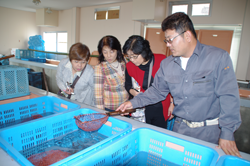 The members of the Seikatsu Club also visited a farm run by the Fukae Town Fisheries Cooperative, which is well known for its prawn farming. They learned the details of the aquaculture, such as that prawns are nocturnal in nature, how many times per day they are fed, what kind of fish feed is given, how the water from the farm is drained off, and so on.
The members of the Seikatsu Club also visited a farm run by the Fukae Town Fisheries Cooperative, which is well known for its prawn farming. They learned the details of the aquaculture, such as that prawns are nocturnal in nature, how many times per day they are fed, what kind of fish feed is given, how the water from the farm is drained off, and so on.
“This was my first visit to see aquaculture farms,” said Ms. Izumi Ueda, giving her impressions of the visit. “They need a lot of money for facilities, expenses and fish feed. Now I understand why puffer and prawns are expensive. We have to have sustainable aquaculture. When I listened to the presentations about the new products, I realized that small fisheries cooperatives and seafood processors are working very hard to take advantage of their unique characteristics, and the JF Nagasaki Gyoren is working hard to support them. They showed a positive attitude toward us by saying that they have improved some points that were not up to our standard last year. I really felt that they are trying to meet our needs and recognize the value of the interactions between members and producers in the Seikatsu Club.”
生活クラブをはじめませんか?
42万人が選ぶ安心食材の宅配生協です
ウェブ加入限定 無料プレゼント






